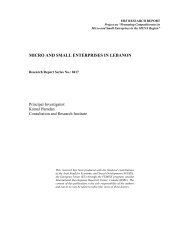Credibility of Inflation Targeting in Morocco and Tunisia Adel ...
Credibility of Inflation Targeting in Morocco and Tunisia Adel ...
Credibility of Inflation Targeting in Morocco and Tunisia Adel ...
You also want an ePaper? Increase the reach of your titles
YUMPU automatically turns print PDFs into web optimized ePapers that Google loves.
The variable st<strong>and</strong>s for the simulated <strong>in</strong>terest rate. In what follows, only the results<br />
concern<strong>in</strong>g a rise by 0.5, 1, 2, 3, 4 <strong>and</strong> 5 po<strong>in</strong>ts are reported. How will the economy <strong>and</strong><br />
the f<strong>in</strong>ancial system react to the <strong>in</strong>terest rate <strong>in</strong>crease, <strong>in</strong> particular when a negative<br />
supply shock occurs?<br />
The ma<strong>in</strong> simulation outcomes are reported <strong>in</strong> table 3 for two ma<strong>in</strong> scenarios. The<br />
variables followed by the <strong>in</strong>dex i are those generated under scenario i where i{1, 2}.<br />
The first scenario (i=1) is when BCT decides to <strong>in</strong>crease its <strong>in</strong>terest rate by three po<strong>in</strong>ts<br />
because <strong>in</strong>flation has gone up from 1.4% to 3.35% <strong>in</strong> order to br<strong>in</strong>g down to 3% (more or<br />
less 0.3%). The second scenario (i=2) starts with a higher rate <strong>of</strong> <strong>in</strong>flation <strong>and</strong> a supply<br />
shock. We assumed that the supply shock happens right after the moment BCT decided to<br />
<strong>in</strong>crease its <strong>in</strong>terest rate (that is <strong>in</strong> 2003:Q1). As to the size <strong>of</strong> the shock it is assumed to<br />
equal to three st<strong>and</strong>ard deviations <strong>of</strong> the unanticipated component <strong>of</strong> the output.<br />
The simulation outcomes show that the rise <strong>of</strong> the <strong>in</strong>terest rate is relatively effective <strong>in</strong><br />
br<strong>in</strong>g<strong>in</strong>g down <strong>in</strong>flation as shown to its target. At the same time, the NPLs slightly<br />
slowdown when compared to their historical dynamics. However, under the second<br />
scenario, the opposite happens: <strong>in</strong>flation goes up significantly <strong>in</strong>stead <strong>of</strong> go<strong>in</strong>g down <strong>and</strong><br />
the NPLs <strong>in</strong>crease immediately. It is worth not<strong>in</strong>g that the <strong>in</strong>flation <strong>in</strong>crease seems both<br />
important <strong>and</strong> realistic.<br />
Clearly, the simulation output throws doubt on the effectiveness <strong>of</strong> the IT under the<br />
present bank<strong>in</strong>g system situation. Because the system is too fragile, the impact <strong>of</strong> a<br />
negative supply shock will limit the effectiveness <strong>of</strong> IT. A failure <strong>of</strong> the IT policy may<br />
also be obta<strong>in</strong>ed if despite the <strong>in</strong>terest rate <strong>in</strong>crease the central bank f<strong>in</strong>ds itself under the<br />
obligation to create more high powered money as a result <strong>of</strong> high fiscal deficit that the<br />
government could not manage to f<strong>in</strong>ance otherwise.<br />
More actions <strong>and</strong> reforms should therefore be undertaken <strong>in</strong> order to help the bank<strong>in</strong>g<br />
system st<strong>and</strong> on its feet.<br />
The overall conclusions is that a lot rema<strong>in</strong>s to be done before committ<strong>in</strong>g the country to<br />
move to IT <strong>in</strong> terms <strong>of</strong> f<strong>in</strong>ancial <strong>and</strong> fiscal soundness <strong>and</strong> discipl<strong>in</strong>e <strong>and</strong> <strong>in</strong> terms <strong>of</strong><br />
<strong>in</strong>stitutional <strong>and</strong> governance design symbolized by the <strong>in</strong>dependence <strong>of</strong> the central bank.<br />
Fiscal discipl<strong>in</strong>e <strong>and</strong> a deep transformation <strong>of</strong> the rules <strong>of</strong> the game with<strong>in</strong> the f<strong>in</strong>ancial<br />
system are <strong>in</strong> fact a necessity for the success <strong>of</strong> IT or any other sound monetary policy.<br />
These transformations are conceivable <strong>in</strong> countries like <strong>Morocco</strong> <strong>and</strong> <strong>Tunisia</strong> but not<br />
costless <strong>in</strong> terms <strong>of</strong> public f<strong>in</strong>ance <strong>and</strong> most <strong>of</strong> all <strong>in</strong> terms <strong>of</strong> <strong>in</strong>stitutional <strong>and</strong> political<br />
requirements. The key issue, which is beyond this model, is whether the current policy<br />
makers have the <strong>in</strong>centive <strong>and</strong> are likely to undertake the necessary moves given their<br />
political possibilities <strong>and</strong> <strong>in</strong>terest? For the moment, the cost <strong>of</strong> do<strong>in</strong>g so <strong>and</strong> the<br />
uncerta<strong>in</strong>ties l<strong>in</strong>ked to the transition to IT makes it unlikely to expect such a transition<br />
21

















